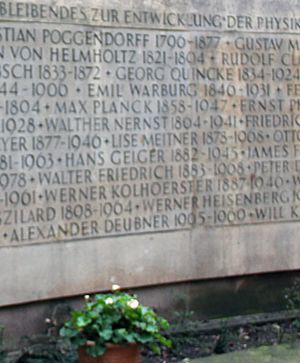Werner Kolhörster facts for kids
Werner Heinrich Gustav Kolhörster (born December 28, 1887 – died August 5, 1946) was a German physicist. He was one of the first scientists to study cosmic rays.
Contents
Early Life and Education
Werner Kolhörster was born in a place called Schwiebus (now Świebodzin) in Germany. He went to the University of Halle. There, he studied physics with a professor named Friedrich Ernst Dorn.
Discovering Cosmic Rays
Repeating Victor Hess's Experiments
In 1913 and 1914, Kolhörster did experiments similar to those of another scientist, Victor Hess. He used a balloon to go very high up, about 9 kilometers (which is about 5.6 miles) into the sky.
Evidence from High Altitudes
At this high altitude, Kolhörster found that the amount of radiation (called ionization) was much stronger than it was on the ground. This important discovery helped prove that these mysterious rays, now known as cosmic rays, were coming from far above Earth's atmosphere.
Career and Research
Joining the Physikalisch-Technische Reichsanstalt
After his balloon experiments, Kolhörster continued his physics studies. In 1914, he joined a research institute in Berlin called the Physikalisch-Technische Reichsanstalt.
Work During World War I
During World War I, Kolhörster worked in Turkey. He measured how electricity behaved in the atmosphere. After the war, he became a teacher. He returned to the Physikalisch-Technische Reichsanstalt in 1922.
Proving Cosmic Rays are Charged Particles
In 1928 and 1929, Kolhörster worked with Walter Bothe. They used a special device called a Geiger-Muller detector. They showed that cosmic rays were actually tiny charged particles. Because these particles could travel through Earth's atmosphere, it meant they had a lot of energy.
Starting a Cosmic Ray Institute
In 1930, Kolhörster helped start the first institute dedicated to studying cosmic rays. It was in Potsdam, Germany. The Prussian Academy of Sciences helped pay for it. Later, in 1935, he became the director of the Institut für Hohenstrahlungsforschung in Berlin-Dahlem. He was also made a professor there.
Legacy
Werner Kolhörster died in a car accident in Munich in 1946. To honor his work, a crater on the Moon is named after him. It is called Kolhörster.
See also
 In Spanish: Werner Kolhörster para niños
In Spanish: Werner Kolhörster para niños


